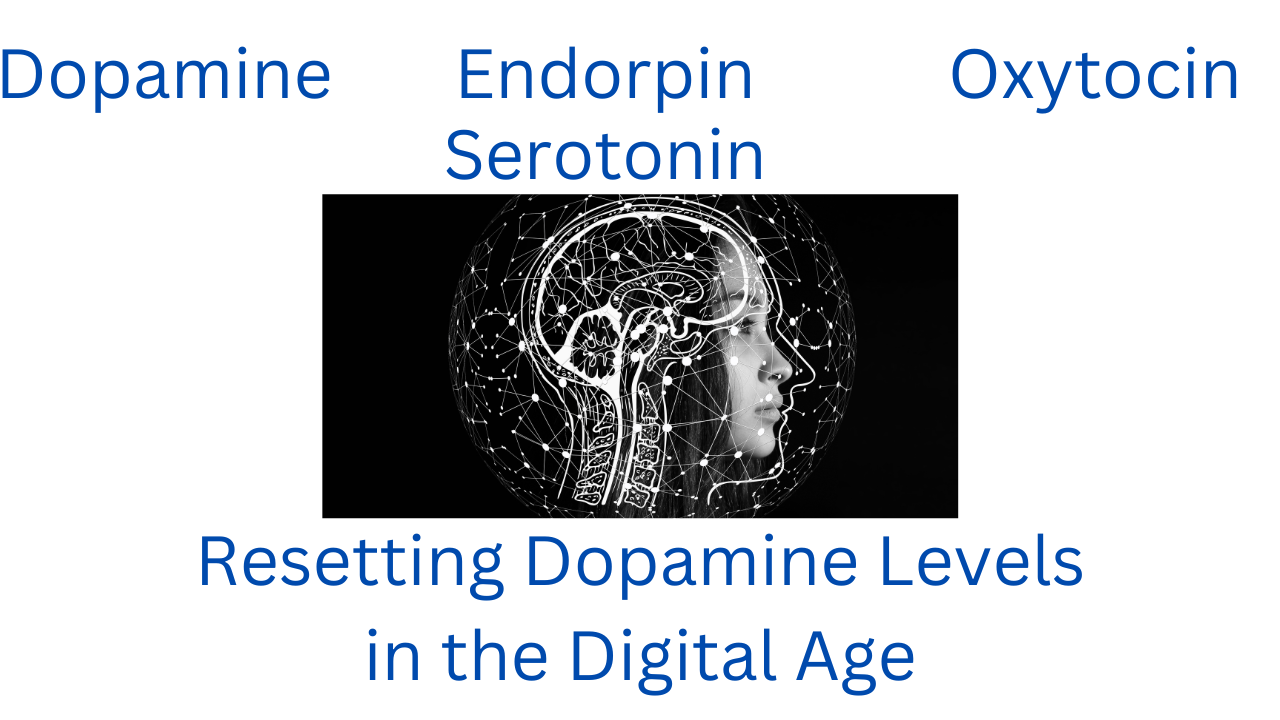Resetting Dopamine Levels in the Digital Age
In this Digital Age where screen time has become an integral part of our daily lives, it’s important to know how screen time affects our brain chemistry. Dopamine often referred to as the feel-good neurotransmitter, plays an important role in our reward and pleasure systems. This article aims to highlight the importance of Resetting dopamine levels and offers practical strategies for achieving a healthy balance in the digital world.

Resetting Dopamine Levels in the Digital Age
Understanding Dopamine and the Digital Effect
Dopamine is a neurotransmitter that regulates various brain functions, including motivation, reward, and pleasure. It is released when we engage in pleasurable activities, such as eating delicious food, engaging in social interactions, or accomplishing a goal. However, the instant gratification provided by digital devices, social media, and online entertainment can disrupt the delicate balance of dopamine in our brains.
The digital dopamine loops
The digital world provides an environment full of immediate rewards, which often trigger the dopamine feedback loop. Every notification, like, or message received releases dopamine, which reinforces the desire for more. This constant stimulation can lead to addictive behaviors and reduce our ability to derive satisfaction from real-life experiences. To regain control of our dopamine levels, it is important to implement strategies that promote healthy habits and the use of mindfulness technologies.
Resetting dopamine levels
- Digital Detox:
Taking a break from digital devices and engaging in activities that don’t involve screens can help reset dopamine levels. Consider setting aside specific times during the day or week for screen-free activities such as exercising, pursuing a hobby, or spending time with loved ones. Disconnecting from the digital world allows our brains to reset and restore a healthy dopamine balance.
- Mindful use of technology:
Practice mindful and intentional use of technology. Set boundaries by setting specific times for checking emails or social media. Avoid using devices before bed to ensure quality sleep, as sleep deprivation can further disrupt dopamine balance. When using technology, try to focus on meaningful activities instead of mindless scrolling. Engage in activities that provide real value and fulfillment.
- Physical Activity:
Regular exercise naturally increases dopamine production. Physical activity not only improves overall health but also helps combat the sedentary nature of excessive screen time. Whether it’s going for a walk, practicing yoga, or participating in a team sport, incorporating physical activity into your routine can positively impact dopamine levels and your overall mood.
- Pursue real-life joys:
Rediscover activities that bring you joy and satisfaction outside the digital realm. This might include spending time outdoors, reading a book, practicing a musical instrument, or engaging in creative activities. By diversifying your sources of pleasure, you can become less dependent on digital stimuli for dopamine release. Real-life experiences offer a deeper and more lasting sense of fulfillment while enhancing your overall well-being
- Social Connections:
Developing meaningful relationships and face-to-face interactions can significantly affect dopamine levels. Engage in social activities, join clubs or organizations, and develop relationships that provide real fulfillment and emotional support. Spending quality time with loved ones and engaging in meaningful conversations can increase the release of dopamine and promote feelings of connection and happiness.
- Mindfulness and Meditation:
Incorporating mindfulness and meditation practices into your routine can help restore dopamine balance by promoting self-awareness and reducing stress. These exercises can increase your ability to appreciate the present moment and reduce the need for constant digital stimulation. By practicing mindfulness, you can become more in tune with your needs and emotions, which can lead to a healthier relationship with technology and a more balanced dopamine system.
While the Digital age offers unprecedented connectivity and convenience, it’s important to recognize the potential negative effects on our dopamine levels and overall well-being. By consciously resetting our dopamine levels and implementing strategies to achieve a healthy balance, we can regain control of our digital habits and enjoy a more fulfilling life both online and offline. can enjoy Resetting dopamine levels requires commitment and self-discipline, but the rewards of less reliance on digital stimuli and improved overall health are undoubtedly worth the effort.
By incorporating these practical strategies into our lives, we can navigate the Digital age with intention, finding a harmonious balance between our online and offline experiences. So, take the first step toward resetting your dopamine levels today, and adopt a healthy relationship with technology. Remember, it’s not about ditching technology, it’s about using it mindfully and finding joy in different real-life experiences. Your mind and well-being will thank you for it.
Furthermore, it is important to recognize that Resetting dopamine levels in the Digital age is an ongoing process. As technology advances and becomes more integrated into our lives, new sources of digital stimulation and potential dopamine imbalances may emerge. Staying informed, adapting our strategies, and regularly reviewing our digital habits are vital to ensure we maintain a healthy relationship with technology.
By prioritizing self-care, setting boundaries, and finding balance, we can actively reset and regulate our dopamine levels, leading to a healthier and more fulfilling life amid a digital landscape. can promote Remember, you have the power to control your digital experiences and prioritize your well-being in the age of technology.
Resetting dopamine levels involves restoring a healthy balance of dopamine neurotransmitters in the brain. Dopamine is responsible for regulating the motivation, reward, and pleasure systems. Excessive screen time, digital stimuli, and addictive behaviors can disrupt dopamine balance, causing imbalances and negative effects on our health. To reset dopamine levels, several strategies can be implemented.
One of the key approaches is a digital detox, which involves taking a break from digital devices and engaging in activities that don’t involve screens. This allows our brains to recalibrate and reduce our reliance on digital stimuli. Mindful use of technology is another important way, where we set boundaries and schedule specific times to check emails or social media. By using technology intentionally, we can avoid excessive dopamine release and regain control of our digital habits.
Physical activity plays an important role in Resetting dopamine levels. Regular exercise has been shown to naturally increase dopamine production, not only improving overall health but also counteracting the sedentary nature of excessive screen time. By incorporating physical activity into our routine, we can promote a healthy dopamine balance and boost our mood.
Pursuing real-life pleasures is another effective strategy. It includes rediscovering activities that bring us joy and satisfaction outside the digital realm. Engaging in hobbies, spending time outdoors, reading, or pursuing creative pursuits can help reduce dependence on digital stimuli for dopamine release. By diversifying our sources of pleasure, we can regain a sense of fulfillment in real-life experiences.
Social connections also play an important role in Resetting dopamine levels. Developing meaningful relationships and engaging in face-to-face interactions can significantly affect dopamine levels. Joining clubs or organizations, spending quality time with loved ones, and cultivating relationships that provide real fulfillment and emotional support can increase our dopamine release and overall well-being.
Mindfulness and meditation practices are powerful tools for Resetting dopamine levels. By incorporating these practices into our daily lives, we can promote self-awareness, reduce stress, and restore dopamine balance. Mindfulness allows us to appreciate the present moment, reduces the need for constant digital stimulation, and increases our overall well-being.
Resetting dopamine levels compare with Serotonin
Resetting Dopamine Levels:
- Definition: Restoring a healthy balance of dopamine neurotransmitters in the brain.
- Function: Regulates motivation, reward, and pleasure systems.
- Impact: Influenced by excessive screen time, digital stimuli, and addictive behaviors.
- Significance: Important to experience happiness and motivation.
- Reset methods: digital detox, use of mindfulness technology, physical activity, pursuit of real-life pleasures, social connections, mindfulness, and meditation.
- Benefits: Better focus, less reliance on digital stimuli, increased satisfaction with real-life experiences.
- Interplay: Serotonin release can be influenced by dopamine levels, and vice versa.
- Signs of Imbalance: Increased impulsivity, addictive-like behavior, decreased enjoyment of real-life activities.
- Reconfiguration Tips: Implement mindfulness technology use, engage in physical activity, pursue real-life pleasures, foster social connections, and practice mindfulness and meditation.
Serotonin:
- Definition: Regulating mood, happiness, and well-being neurotransmitters.
- Function: Regulates mood, emotions, appetite, and social behavior.
- Influence: Influenced by factors such as social interactions, exposure to sunlight, and diet.
- Importance: Important for maintaining a stable mood and emotional well-being.
- Ways to reset: engage in social interaction, spend time outdoors, get sunlight, exercise regularly, maintain a healthy diet, practice gratitude, and engage in activities that bring happiness. are
- Benefits: Improved mood, reduced anxiety, improved emotional resilience, increased feelings of happiness and contentment.
- Interplay: Dopamine and serotonin work together to regulate mood, motivation, and overall health.
- Symptoms of Imbalance: Mood swings, depression, anxiety, decreased sense of well-being, disturbed sleep patterns.
- Reset Tips: Engage in social interaction, spend time in nature, get regular sunlight, maintain a balanced diet, exercise regularly, practice self-care, and when needed Get professional help.
- While dopamine and serotonin are separate neurotransmitters, they both play an important role in maintaining our mental and emotional well-being. Resetting dopamine levels and ensuring a healthy balance of serotonin are both important for overall happiness and fulfillment.






